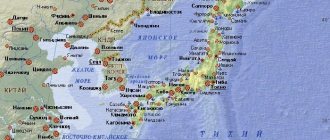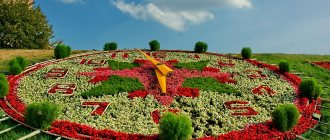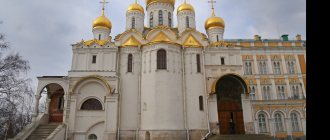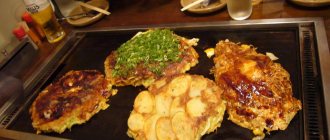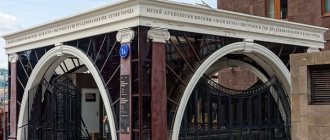Temple Island
The UNESCO heritage-listed island is part of a national reserve. Its nature is unique - animals and birds roam here completely freely and are not afraid of people.
The sacred island is good to visit at any time of the year, because in the spring sakura blooms here, in the summer the surrounding forests are filled with the sounds of birds, and in the fall the famous maples turn the island into a huge crimson bonfire.
But Itsukushima is famous not for this, but for its ancient shrine, which attracts adherents of Shintoism and connoisseurs of ancient architecture.
What to see
The temple is a complex complex of 17 wooden buildings. The ancient Japanese believed that the sacred land of the gods was inviolable, so the Itsukushima Shrine was built on stilts driven into the seabed. The main prayer hall is dedicated to Amaterasu and her two sisters, and the kagura pantomime dance is performed here, telling the story of the departure and return of the Sun Goddess.
A carved bridge leads onto solid ground to the temple treasury. About 4,000 relics of the Shinto cult are kept there - ancient swords, fans, precious porcelain, jade jewelry, cups and ancient manuscripts.
The platform on which the buildings stand is not solid; there are gaps between the boards. Heels get stuck in them, so women should wear comfortable shoes. When the tide goes out, the bottom is exposed, and you can walk up to the gate, touch it, put a coin in the slot and make a wish. If it is sincere, it will definitely come true.
The best time to visit the island is autumn, which colors the surrounding forests in all shades of yellow and red. Once you see the sunset outside the gates of Itsukushima, you begin to understand why the Japanese deify nature.
Gateway to the Spirit World
The sacred complex, dedicated to the daughters of the Japanese god, was built more than one and a half thousand years ago, but was repeatedly destroyed by natural disasters. Many noble residents of the country took on the task of restoring the temple, and in the 16th century they managed to create a solid structure. According to legend, the largest hall of the temple, the “hall of a thousand mats,” was built from the trunk of just one camphor tree.
But the most important value of the temple is located not on the island, but in the sea, not far from the shore. These are the famous torii, which have become the unspoken symbol of Japan, the gate separating the world of the living from the world of spirits.
This gate is 16 meters high and can be reached on foot at low tide. It is believed that after passing through them, you will find yourself in the world of spirits and feel amazing peace.
Perhaps in ancient times the Japanese could feel something similar when moving away from the shore, but now, when hundreds of tourists besiege Itsukushima every day, there can be no talk of any magical silence glorified in ancient literature.
Miyajima, sacred island of Japan
The island of Miyajima is considered so sacred by the Japanese that for many centuries people of low birth were not allowed here.
The Japanese's concern for preserving the sacred purity of the island was expressed in the fact that until the beginning of the 20th century. no woman could set foot on Miyajima, so as not to desecrate him. The same desire to protect the sanctity of the island also explains the ban on burying bodies on the island, because, according to the canons of Shintoism, nothing unclean should be done in such a place, which included childbirth and funerals. Therefore, there is no cemetery on the island, and the deceased are transported from Itsukushima.
Also interesting: Devil's Island Alcatraz
Not far from the shore, right from the depths of the waters, a wooden torii gate rises, whose outlines are known all over the world thanks to both examples of traditional art - ancient woodcuts and fans, and the efforts of modern mass media, which have replicated the image of the gate throughout the world as an image of Japan. The torii gate is the personification of the symbolic passage directly to the main shrine of the island. There were some secrets here: the ancient architects, trying to give this passage beauty and elegance, carefully studied the periodicity and height of the tides of the Inland Sea of Japan, which is very shallow in this place. Depending on the fluctuations in water level, the appearance of the corridors and the foundation of the Itsukushima Temple itself and its entire volumetric composition changes, which is the personification of the constancy of the cycle of life.
Another famous building on the island of Miyajima is the Buddhist monastery Daiganji , dedicated to the goddess Benten and considered perhaps the oldest in Japan.
The nearby Five-Storied Pagoda casts a shadow on the Hall of a Thousand Tatami (Senjokaku), built by the personal order of the military ruler Toyotomi Hideyoshi, and today called the Hideyoshi Memorial Shrine.
The monkeys, which have become familiar on the island and which, together with the deer, wander along the embankment and mountain paths of Momijidani (Maple Valley) Park, were brought here only in 1962 for the needs of the local branch of the Japanese Center for the Study of Monkeys in the Wild. Monkeys and deer are fed by visitors to the island who come to pray at the Miyajima Shrine, ride the cable car to the top of Mount Misen, where the life of the Buddhist priest Kobo Daishi (774-835) is connected, and breathe the clean forest air.
At the foot of Mount Misen is Daisho-in , one of the most popular temples of the Shingon Buddhist sect and one of the main temples in western Japan. Here the founder of the sect, Kobo Daishi, first began to practice Buddhism on the island of Miyajima. In the 12th century, Emperor Toba founded his prayer hall here. Daisho-in maintained close ties with the Imperial family until the 19th century. In 2006, the Dalai Lama himself came to the 1200th anniversary of the temple.
At the main gate to Niomon
there are statues of the Gate Guardians.
Also interesting: The medieval city of Avignon, papal residence
In Daisho-in you can find many buildings, statues and other objects of religious worship, often looking very strange to a foreign gaijin.
Of particular interest are the Kannon-do and Maniden halls, the sand mandala created by visiting monks from Tibet and the Henjokutsu cave, where 88 images representing the pilgrimage temples of Shikoku are hung.
Henjokutsu
There are especially many statues of jizo (a popular Japanese deity in the form of a monk, often dressed in a red scarf or knitted hat) on the territory of the monastery.
In the main altar of the Kannon-do hall there is a statue of the goddess Kannon, and in front of it is a mandala made of multi-colored sand, made by Tibetan priests.
Kannon-do
On the terrace of Kannon-do there is a red head with bulging eyes. This is Daruma, a stylized depiction of Bodhidharma, the founder of Zen Buddhism. Such dolls are used in the ritual of making New Year's wishes. First you need to buy a daruma from a Buddhist temple and, making a wish, draw a pupil in one of its eyes. If the wish comes true for the New Year, they draw a pupil in the other eye, if not, they take it to the temple, burn it and buy a new one. Burning the daruma is a message to the Shinto gods-kami, saying that I am looking for alternative ways to realize my desire from the Buddha.
Chokugan-do Hall
, the entrance of which is just opposite the Onarimon gate. Along the steps of the porch there are 20 wooden statues, 10 on each side. Inside there is one large and a thousand small statues of Fudo Myo-o, one of the Five Wisdom Kings.
On the western side of Itsukushima Shrine is the oldest surviving stage for theatrical performances in Japan. When night falls over the Itsukushima Shrine, religious ceremonies begin here, during which gagaku is certainly played - classical Japanese Shinto religious music that originated in the 8th century, during the Nara period. Gagaku music accompanies the bugaku music and dance performance.
Near Mount Misen, which rises nearby, there is another temple on the island - Gunmo Temple (Gunmo-ji-jo). Twice a year - on April 15 and November 15 - a fire ceremony is held here, where ascetic monks walk barefoot through the hot ash - an art that requires great concentration, which the monks achieve by reciting prayers while fixing their gaze on the outlines of Itsukushima Island's temples.
Itsukushima Shrine
photo-shutterstock. by Sean Pavone
The island of Miyajima is home to the Itsukushima Shinto shrine, which dates back more than 1,400 years and is a World Heritage Site. The scarlet torii gate, rising in a picturesque bay, is the pride of a Shinto shrine. The blue sea and green virgin forests recreate the elegance of the Heian era.
Since ancient times, people have revered the spirits of Miyajima Island, respecting and worshiping the island as a goddess. In 563, by order of Empress Suiko, a shrine was founded on the island of Itsukushima to honor the three goddesses of the sea and trade - Tagir Himei, Ikishima Himei and Tagitsu Himei. It was built by the owner of the Aki Province, Saeki no Kuramoto. His descendants became lifelong priests of this sanctuary. It is believed that this place is the confluence of all the spirits of nature, so the choice of the goddess fell on this place. The first account of Itsukushima Shrine in Japanese history was dated 811 in the Nihon Koki (Notes on Japan).
During the era of the Japanese politician and commander Taira no Kiyomori, this place was a temple for the Heike clan. The main shrine building was rebuilt around 1168 by order of Taira no Kiyomori in connection with his plans to develop the commercial infrastructure of the Inland Sea of Japan. Two palaces for the deities were erected, which were symmetrically located opposite each other, and a huge 16-meter torii gate rose in front of them. The sanctuary was placed on a platform near the seashore in such a way that during high tide the structure looked like it was floating on the water. Thanks to the reconstruction of Taira no Kiyomori, Itsukushima Shrine became the main shrine of Aki Province, taking over leadership from the ancient shrine of the Saeki family, Hayatani jinja.
As the Heike clan's power increased, the number of worshipers at the shrine increased and the shrine became famous among members of the Imperial Court. The Emperor and the Imperial Court paid visits to the shrine, and the culture (architecture) of the Heian period (794-1185) was approved by the Emperor. The ancient Japanese musical dance Bugaku also originated during this period. Even after the fall of the Heike clan, the culture of the Heian period was warmly accepted by the Genji clan, and the shrine continued to flourish.
The main shrine was damaged by fire in 1207 and 1223, and although the restoration was carried out with the accuracy of the original, it is believed that with each restoration, the scale of the shrine changed. Thus, in the illustration, which was drawn during the Koan period (1278-1288), the location of the shrine is different. This is because the shrine was destroyed by a typhoon in 1325, and from then on the location became similar to the present one.
Since the Kamakura period (1185–1333) and civil wars (Sengoku period), when the political situation was unstable, the influence of the shrine gradually decreased and only in 1555, under the influence of the most powerful daimyo in Western Japan, Mori Motonari, the shrine was restored to its former splendor and reverence. In addition, the great commander Toyotomi Hideyoshi, after an expedition to Korea, ordered the construction of a large library for Buddhist sutras here.
Itsukushima Shrine, which has been respected and revered by many common people and aristocrats since ancient times and throughout history, is an example of rare and unique architectural design, a symbol of Japanese culture and history that is alive and continues to this day.
Detailed history of the temple
Construction of the shrine in the Shinden style began in 1168 under the orders of Taira no Kiyomori. The main (inner) shrine consists of 37 buildings and the outer shrine, the structure of which is located on both sides of the shore, and consists of 19 buildings. When Taira no Kiyomori was appointed governor of Aki Province in 1146, he established a foundation for the main shrine, and the greatness The shrine became more magnificent. Although the main buildings of Itsukushima Shrine were built during the Heian period, due to fires and other disasters over time, the existing main shrine was only built in 1571, and the Marodo Shrine in 1241.
There may be minor differences in the details of the buildings, which reflect the period during which they were built, but the overall architectural style is perfectly preserved. Scientific research and analysis aside, the shrines are a magnificent example of Heian period architecture, including the Shinden style of Japanese architecture, which are harmoniously mixed. The shrine is the finest example of this type of architecture existing in Japan.
The main shrine is built in the subtle and magnificent kiritsuma-ryonagare style, and the façade, whose diamond-shaped doors and grilles are lacquered in a greenish-blue color, emphasizes this elegant and graceful style. The building was built in 1571 by Mori Motonari, in the same Heian architectural style that was skillfully reproduced by Kiyomori, and the characteristic, graceful lines of this style are seen throughout. The Shinden style of architecture was used during the Heian period for the construction of housing for the Emperor and the noble class, and an example of this style of architecture is the Imperial Palace in Kyoto.
During construction, it was planned to build the mythical Ryugu-jo (Dragon Palace) in the sea by any means possible, because according to legend it is guarded by the goddess of the sea. According to another version, it was built as a manifestation of faith in the Buddhist Pure Land faith during the Fujiwara period. It was believed that when people die, their souls travel in boats to the "other world" to enter Gokuraku Jodo (heaven, Buddhist Pure Land). Whatever the version, the shrine truly amazes with its magnificent appearance, which unites the harmony and beauty of human skill and nature.
Since the shrine was built in the sea, a fund has been created to preserve it. The shrine is subject to sea tides and typhoons, but thanks to careful care, almost 800 years have passed, and Itsukushima Shrine can be seen in its original form.
The eastern and western corridors present a picturesque picture. The corridors are designated as a national treasure on March 29, 1952. The eastern corridor extends from the entrance of Itsukushima Shrine, past the Morodo Shrine and the Asazaya Hall (morning service hall) to the Main Hall. The corridor has 108 “mamas” (an indeterminate measurement is a gap or bay between the pillars, so 8 mamas are 8 spaces between 9 pillars) along the bay and 4 meters in width. Small spaces between the floorboards of the corridor (without a single nail) were created to ease the influx of the tide. And the western corridor, which used to be the entrance since ships followed the southern route before Taira no Kiyomori opened the Ondo no Seto route, is now the exit from the shrine. The Naishi Bridge, a national treasure of Japan, is also of great interest. During the Heian period, women who served in the temple were called "naishi" and in those days naishi crossed this bridge to carry food for the gods. Visitors to the temple complex linger in the Kharais (purification hall) to purify their mind and body before offering prayers.
Among all the buildings at Itsukushima Shrine, only the purification halls, main shrines, main shrine, and Marodo Shrine have lattice ceilings. The purification hall of the Marodo Shrine differs from the main shrine in that the surrounding parapet has a part of the hall open to the sea. The purification hall was used for monthly festivals and for performing the ancient Bugaku dance on rainy days. The central part of the front cornice is shortened and raised, and is a typical architectural style used in the Amida Buddha Halls of the late Heian period, and was applied in the Bedo-in Rama Phoenix Hall in Uji Kyoto, the Amida Hall of Hokaiji Temple in Hino Kyoto and other famous temples Designated a national treasure on March 29, 1952, Marodo Shrine is the largest structure in Itsukushima dedicated to the five deities. The retreat room is located on one side of the hall and the sutra chambers on the other, where the priests read the sutras.
The passages of the corridors are hung with hanging lanterns. They were originally dedicated to Terumoto Mori, the grandson of Motonari Mori. Lanterns of those days were made of iron and the shape was different from what we see today. They are now kept in the Hall of Treasures. The existing lanterns were cast in bronze in early 1900, which were modeled after earlier designs from 1366.
While walking around Itsukushima Shrine, guests can see the three Kagami no Ike Mirror Ponds. According to legend, the ponds appeared one night when Itsukushima Shrine was built during the era of Empress Suiko. Thus, the people of those days believed that the construction of the shrine satisfied the gods. The reservoirs served as fire reservoirs. Kagami-no-ike is one of the eight inspirations of Miyajima Island. The moon reflecting on the "mirror pond" was the most beautiful scene that appeared repeatedly in tanka (Japanese poetry with 31 syllables) and haiku motifs. Here you can also see a pool of water from where water was previously drawn for the needs of the temple. The stone pool was made from one huge stone in 1592.
Fans of the Heian Sei Senagon classic "Notes at the Bedside" will be interested in visiting the Asazaya Hall, the hall for morning Shinto ceremonies, where some of the action of the work takes place. And the sotoba stone (an important cultural property) is famous for its story from the collection "Monogatari of the Heike Clan": Taira no Yasuyori, exiled to Kikaiga Island in Kagoshima Prefecture after an unsuccessful attempt to plot against Taira no Kiyomori, indulged in writing poetry that expressed his longing for Kyoto and a missing mother. He composed more than 1000 poems and left each one on a wooden tablet floating in the sea. One of the planks was washed up by a wave on the shore of Miyajima Island. The priest, who found the tablet in the stone, took it to the temple and Yasuyori was allowed to return to Kyoto.
There is also a Tenjin shrine on the island - dedicated to the famous Japanese statesman and scientist Sugawara no Michizane (the deity of education Tenjin). The Tenjin Shrine and the Noh theater stage retain their natural color, contrasting with the bright red lacquer decorations of Itsukushima, showing that they were built in a later period (1556 by Mori Takamoto). Here, for 100 years before the Meiji period, traditional renga poetry recitation ceremonies were held on the 25th of every month. The first performance was staged on the Noh stage in 1568, when the great Kanze Dayu himself (Zeami Motokye - founder of the Noh theater) performed here.
The annual traditional Kangensai festival, which takes place on June 17th of the lunar calendar, attracts thousands of visitors. An orchestra is carried aboard the boats, colorfully decorated with curtains and lanterns, and passing through the Torii gate they enter Masugata Bay late at night. Kangen is a type of musical piece performed by flute, drums and Japanese string instruments. In the ancient capital of Kyoto, nobles enjoyed performing kangen while boating along the river. At the Itsukushima Shrine, this holiday was started 800 years ago by Taira no Kiyomori. This Shinto ceremony later grew into the Boat Festival, famous throughout Japan.


